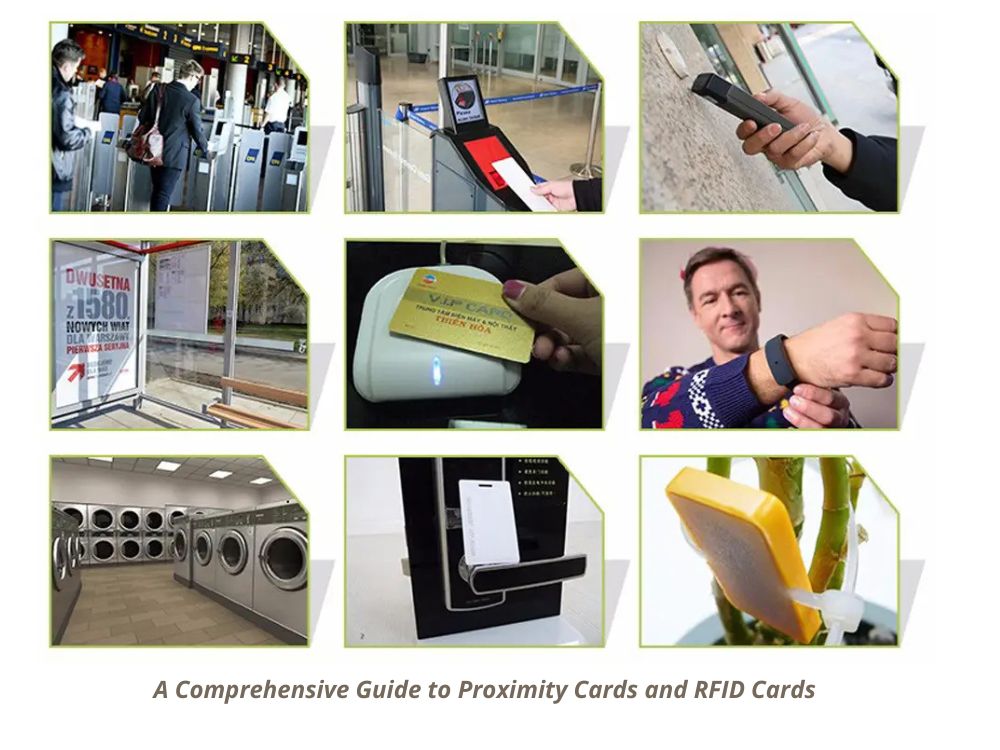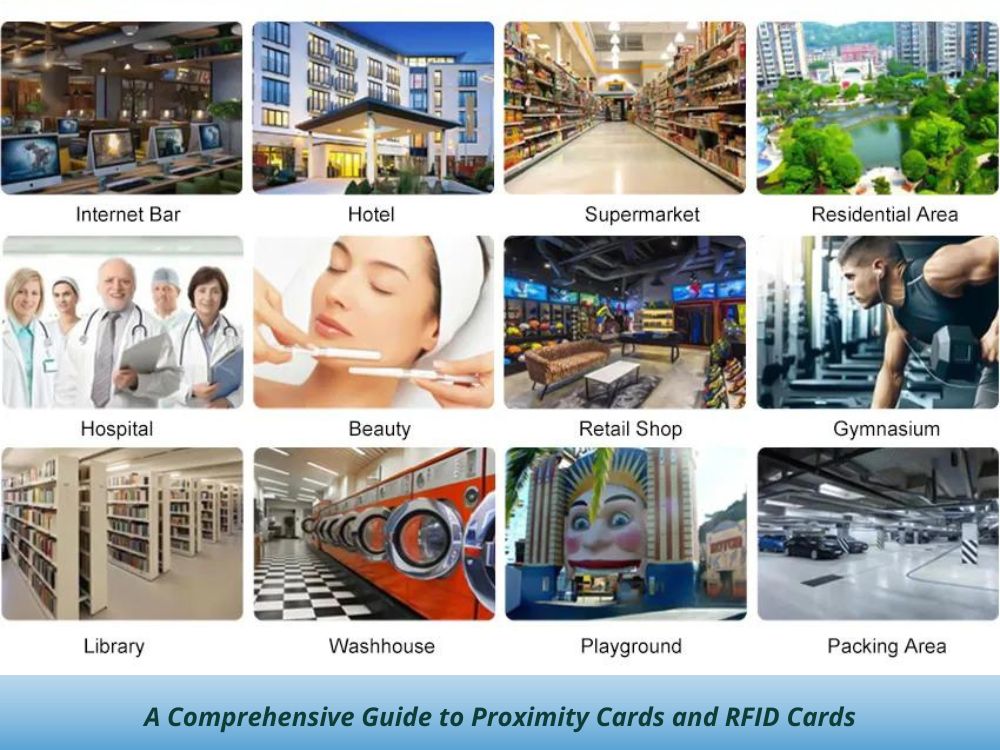
A Comprehensive Guide to Proximity Cards and RFID Cards
Table of Contents
Summary
While both card types utilize radio-frequency technology, their operational frequencies, capabilities, and applications differ significantly. This article delves into the specifics of RFID proximity cards and RFID cards, highlighting their respective technologies, functionalities, and key differences.

What Are Proximity Cards?
RFID Proximity Cards are a type of contactless smart card that operates at a low frequency, typically around 125kHz. These cards are primarily used for access control in secure environments. They are designed to be read at close range, often within a few centimeters of a card reader. The card’s embedded transmitter sends data to the reader, allowing quick verification of the user’s credentials.
Key Features of Proximity Cards:
- Frequency:Low-frequency (125kHz)
- Range:Short-range (a few centimeters)
- Functionality:Read-only
- Primary Use:Access control
What Are RFID Cards?
RFID (Radio-Frequency Identification) Cards utilize electromagnetic fields to communicate with a reader via an internal chip. These cards are available in active and passive forms. Active RFID cards have an internal battery, enabling communication over long distances (up to 100 meters), while passive RFID cards rely on the reader’s signal for power and are limited to shorter ranges.
Key Features of RFID Cards:
- Frequency:Can operate at low, high, or ultra-high frequencies (typically 13.56MHz)
- Range:Varies from a few centimeters to over 100 meters, depending on the tag type
- Functionality:Read/write capabilities
- Primary Use:Access control, tracking, logistics, and more
Key Differences Between Proximity Cards and RFID Cards
Feature | Proximity Cards | RFID Cards |
Frequency | 125kHz | Typically 13.56MHz (can vary) |
Range | A few centimeters | From centimeters to over 100 meters |
Line of Sight | Required due to limited range | Not required |
Functionality | Read-only | Read/write capabilities |
Information Storage | Limited | More flexible and capable of storing more data |
Typical Applications | Access control | Access control, logistics, tracking, and more |
In-Depth Analysis of Proximity Cards
Frequency and Range
Proximity cards operate at a low frequency of 125kHz, which limits their read range to just a few centimeters. This short-range functionality is particularly suited for secure access control systems where close proximity is necessary to authenticate users, reducing the risk of unauthorized access.
Security Features
Due to their read-only nature, proximity cards offer a stable and reliable security solution. However, they lack the flexibility of data storage and writing capabilities, which limits their use to simple access control systems without the need for data interaction.

Detailed Examination of RFID Cards
Frequency Versatility
RFID cards operate across a wider range of frequencies, typically at 13.56MHz, but can also function at low or ultra-high frequencies depending on the application. This frequency versatility allows RFID cards to be used in a broader range of environments, from close-range identification to long-distance tracking.
Extended Range and Functionality
The ability of RFID cards to communicate over longer distances, especially with active tags, makes them ideal for applications beyond simple access control. They are widely used in logistics, asset tracking, and even race timing systems, where long-range communication is essential.
Conclusion
While both proximity cards and RFID cards leverage radio-frequency technology, their operational differences make them suitable for distinct applications. Proximity cards excel in short-range, read-only access control, whereas RFID cards offer greater flexibility with read/write capabilities, extended range, and diverse frequency options. Understanding these distinctions will guide you in selecting the appropriate card technology for your specific needs.
Comments
Hot Products

What Is RFID Waste Management
Imagine a city where every trash bin speaks — not literally — but through a tiny chip that tells the system when it’s full, when it’s emptied, and where it went. That’s what RFID waste management is doing today.

What are Bolt Seals and their Applications? | Complete Guide
In global trade and logistics, bolt seals play a crucial role in ensuring cargo security and compliance. These small but powerful devices are designed to lock shipping containers, trailers, and cargo doors with a tamper-evident mechanism.

What is an RFID Card Protector? Benefits, Use Cases, and Buying Guide
RFID technology (Radio Frequency Identification) is everywhere: in your credit cards, ID badges, transit passes, hotel room keys, and more. It offers speed and convenience, but it also opens the door to a new kind of digital theft called “skimming.” That’s where an RFID card protector comes in.

RFID Wristbands for Events: Bulk Buying Guide for Organizers
RFID wristbands for events are becoming the go-to solution for organizers who need faster entry, fraud prevention, and cashless payments at concerts, festivals, and sports venues. Unlike paper tickets or QR codes, these smart wristbands use embedded chips to streamline access, secure transactions, and improve the guest experience.

How RFID Tag on Windscreen Improves Vehicle Access Control and Toll Systems
In today’s fast-paced world, vehicle identification needs to be quick, secure, and contactless. An RFID Tag on the Windscreen provides exactly that — a reliable way to manage toll collection, parking, and gated access without stopping vehicles.

The Benefits of RFID Linen Tags in Commercial Laundry
Managing laundry in hospitals, hotels, or large laundry services is a big job. Each day, thousands of sheets, towels, and uniforms are washed, sorted, and sent back out. But problems like lost linens, sorting mistakes, and manual counting can cost companies a lot of money. For example, mid-sized hotels can lose over $200,000 each year from missing linens.
That’s where RFID Linen Tags come in.
Tags
RELATED BLOGS

What Is RFID Waste Management
Imagine a city where every trash bin speaks — not literally — but through a tiny chip that tells the system when it’s full, when it’s emptied, and where it went. That’s what RFID waste management is doing today.

What are Bolt Seals and their Applications? | Complete Guide
In global trade and logistics, bolt seals play a crucial role in ensuring cargo security and compliance. These small but powerful devices are designed to lock shipping containers, trailers, and cargo doors with a tamper-evident mechanism.

What is an RFID Card Protector? Benefits, Use Cases, and Buying Guide
RFID technology (Radio Frequency Identification) is everywhere: in your credit cards, ID badges, transit passes, hotel room keys, and more. It offers speed and convenience, but it also opens the door to a new kind of digital theft called “skimming.” That’s where an RFID card protector comes in.




